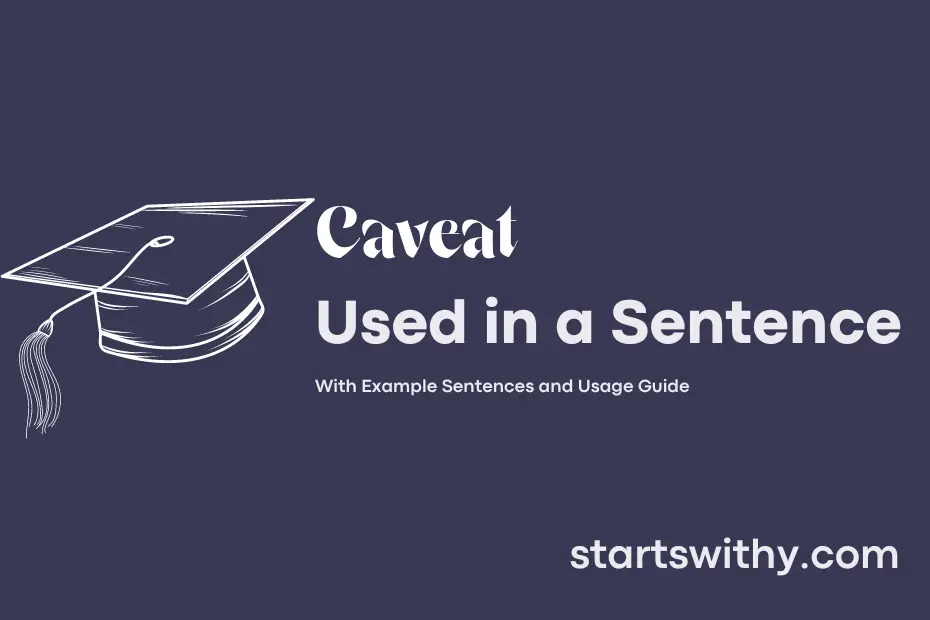Navigating through complex information can be daunting, but with the right knowledge, it becomes more manageable. One important concept to grasp is the notion of a “caveat.” In simple terms, a caveat serves as a warning or caution that must be considered before proceeding.
When encountering a caveat, it’s crucial to fully understand its implications and potential consequences. By paying attention to these caveats, individuals can make more informed decisions and avoid unnecessary risks. Let’s delve deeper into the significance of caveats and how they can guide us in various situations.
7 Examples Of Caveat Used In a Sentence For Kids
- Caveat means a warning or caution.
- Always listen to your teacher’s caveat before starting a new activity.
- It’s important to pay attention to the caveat on signs to stay safe.
- Remember the caveat about not running in the school corridors.
- The librarian had a caveat about keeping the books clean and neat.
- The caveat on the science experiment was to wear safety goggles.
- Before crossing the road, always remember the caveat to look both ways.
14 Sentences with Caveat Examples
- Make sure to attend all your classes regularly, caveat being that you shouldn’t hesitate to ask for clarifications on any confusing topics.
- Plan your study schedule wisely, with a caveat that you should also set aside some time for relaxation and self-care.
- When working on group projects, ensure everyone’s responsibilities are clearly defined, with the caveat that you communicate regularly and address any conflicts promptly.
- Utilize the library resources for research purposes, caveat that you properly cite all your sources to avoid plagiarism.
- Stay organized by keeping track of important deadlines and exam dates, caveat being that you also allow yourself some flexibility for unexpected events.
- Take advantage of extracurricular activities to enhance your skills and network, caveat that you prioritize your academic commitments.
- Review lecture notes regularly to reinforce your understanding of the material, caveat being that you engage in active learning techniques to retain information better.
- Seek guidance from professors or mentors whenever you feel stuck, with the caveat that you approach them respectfully and prepared with specific questions.
- Make healthy food choices to fuel your brain and body, caveat that you also indulge in occasional treats to maintain a balanced lifestyle.
- Develop time management skills to juggle assignments and exams effectively, caveat that you also set aside time for hobbies and interests outside of studies.
- Join study groups to collaborate with peers and gain different perspectives, caveat being that you contribute actively and stay focused on the task at hand.
- Use online learning platforms for additional practice and resources, caveat being mindful of distractions and setting aside dedicated study time offline.
- Explore internship opportunities to gain practical experience in your field, caveat being that you balance work commitments with your academic workload.
- Take care of your mental health by seeking counseling or support services as needed, caveat being that you prioritize self-care practices such as mindfulness and exercise.
How To Use Caveat in Sentences?
Caveat is a useful word that can help to add clarity and context to your sentences. It is important to understand how to use it correctly in order to communicate effectively.
When using caveat in a sentence, it is typically placed at the beginning to introduce a warning or caution. For example, “caveat: the product may contain nuts” alerts the reader to be mindful of potential allergens.
A common way to use caveat is to present a condition or limitation before providing information or making a statement. For instance, “I enjoy the movie overall; caveat, the ending was a bit disappointing” sets the stage for the following critique.
In more formal settings, you can use caveat to introduce a legal or ethical consideration. For instance, “She agreed to lend him the money; however, with the caveat that it must be repaid within a month” emphasizes the specific terms of the agreement.
Remember, when using caveat in a sentence, make sure it is relevant and adds value to your point. Avoid overusing it or placing it haphazardly within your writing. With practice, you will become more comfortable incorporating caveat into your communication to provide important context and nuance.
Conclusion
In conclusion, sentences with a caveat serve an essential purpose in communication by providing a warning or limitation to the information being shared. These sentences help to clarify potential misunderstandings or uncertainties, ensuring that the audience is aware of important conditions or exceptions to the statement being made.
By using sentences with caveats, writers and speakers can enhance the transparency and accuracy of their message, maintaining honesty and integrity in their communication. It is crucial to incorporate caveats in sentences to promote clear and effective communication, enabling the audience to have a better understanding of the context and any potential limitations associated with the information provided.



